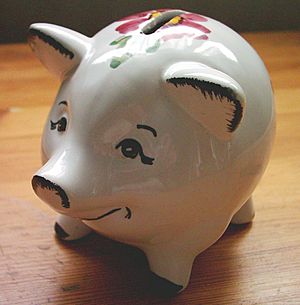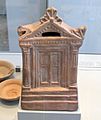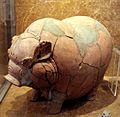Piggy bank facts for kids
A piggy bank is a special container used to save coins and money. It often looks like a cute pig, but you can find them in many different shapes, sizes, and colors! Parents often use piggy banks to teach their children how to save money and understand its value. It's a fun way to learn about being responsible with your cash.
Contents
The History of Piggy Banks
Have you ever wondered why it's called a "piggy bank" and where the idea came from? The exact story is a bit of a mystery, but there are some interesting ideas!
Where Did the Name "Piggy" Come From?
One popular theory suggests that the word "piggy" might have come from an old English word: "pygg." In the Middle Ages, "pygg" was a type of orange-colored clay. People used this clay to make everyday items like bowls, pots, and jars. Sometimes, they would use these "pygg" pots to store their salt or extra money. Over time, these pots became known as "pygg pots" or "pygg banks."
As the English language changed, the word "pygg" sounded more and more like "pig." By the 18th century, people started calling these money containers "pig banks." It wasn't long before potters began making the banks in the actual shape of a pig, making the name "piggy bank" even more fitting!
Ancient Ways to Save Money
Saving money in special containers is not a new idea. People have been doing it for thousands of years!
- Ancient Greece and Rome: Long ago, in places like ancient Greece and Rome, people used small boxes or jars made of clay to keep their coins safe. These early money boxes often had a slot at the top to drop coins in and were sometimes shaped like temples or other everyday objects.
- Medieval Times: During the Middle Ages, people used different kinds of containers, including wooden boxes with locks, or even hollowed-out gourds.
- Asian Traditions: In some parts of Asia, like Nepal and Indonesia, people have traditionally used earthen pots or terracotta figures to save money. The Majapahit Empire, which existed in Southeast Asia centuries ago, even had terracotta piggy banks that looked very similar to the ones we see today.
Why Use a Piggy Bank?
Piggy banks are more than just cute decorations; they are important tools for learning about money.
- Learning to Save: A piggy bank helps kids understand the idea of saving. When you put money into it, you see your savings grow over time. This teaches patience and the reward of waiting for something you want.
- Setting Goals: You can save for a specific toy, a book, or even a gift for someone. Having a goal makes saving more exciting and gives you a reason to keep adding coins.
- Understanding Value: By saving your own money, you start to understand how much things cost and the effort it takes to earn money. This helps you make smarter choices about spending.
- Financial Habits: Starting to save early helps build good financial habits that can last a lifetime. It teaches you to plan for the future and manage your money wisely.
Whether it's a traditional pig shape or something completely different, a piggy bank is a fun and effective way to start your journey into the world of saving!
Images for kids
-
Earthen pots used in Nepal as piggy banks.
-
An ancient Greek money box from Priene, 2nd century BC.
-
Majapahit terracotta piggy bank, 14th/15th century Trowulan, East Java. (Collection of National Museum of Indonesia, Jakarta)
See also
 In Spanish: Hucha para niños
In Spanish: Hucha para niños





